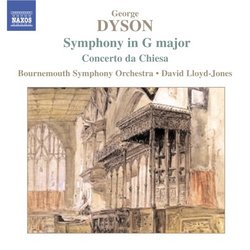| All Artists: George Dyson, David Lloyd-Jones, Bournemouth Symphony Orchestra Title: Dyson: Symphony in G major; Concerto da Chiesa Members Wishing: 0 Total Copies: 0 Label: Naxos Release Date: 9/20/2005 Genre: Classical Styles: Chamber Music, Forms & Genres, Concertos, Theatrical, Incidental & Program Music, Symphonies Number of Discs: 1 SwapaCD Credits: 1 UPC: 747313272020 |
Search - George Dyson, David Lloyd-Jones, Bournemouth Symphony Orchestra :: Dyson: Symphony in G major; Concerto da Chiesa
 | George Dyson, David Lloyd-Jones, Bournemouth Symphony Orchestra Dyson: Symphony in G major; Concerto da Chiesa Genre: Classical
|
Larger Image |
CD Details |
CD ReviewsA Delightful Discovery Warranting a Strong Recommendation J Scott Morrison | Middlebury VT, USA | 10/30/2005 (5 out of 5 stars) "George Dyson (1883-1964), a composer whom I had strangely enough previously known only as the father of the great theoretical physicist Freeman Dyson, was a Yorkshireman who early evinced intense musical talent and who arrived at the Royal College of Music at age 17 and went on to become its Director in 1937. Until this CD I had never heard a note of his music, although I had known of his most-played work the choral 'The Canterbury Pilgrims' from 1930. His son Freeman writes in his autobiography 'Disturbing the Universe' with great love and respect for his father and mentions the acclaim he received for this work. In 1943, during the darkest days of World War II, the now-Sir George Dyson wrote a concert overture, 'At the Tabard Inn,' based on elements of 'Pilgrims.' It is the first band on this CD and is an altogether light-hearted, charming, tuneful and masterful overture in the same vein as Wagner's 'Meistersinger' prelude, albeit unmistakably English in its materials. I cannot imagine why in a lifetime of concert-going I've never encountered this delightful work. It definitely deserves an occasional airing.
Next comes the 'Concerto da Chiesa,' a three-movement work from 1949 based on the concerto da chiesa of baroque times. Hymn tunes, some familiar ('O come, o come, Emmanuel') and some not, are woven throughout the piece. Dyson wrote about it self-effacingly at the time he was working on it, calling the piece 'a churchy one.' It features a solo string quartet and a ripieno orchestral group rather like that of Vaughan Williams's 'Tallis Fantasia' and using some of the same structural gestures. The first movement is intense and almost tortured, and the solo quartet's interjections are pleading in their urgency. The second movement, a set of variations based on 'Corde natus,' is all grace and light. The third movement is lively initially and features some extrovert contributions by the soloists, but it eventuates in an anguished return to the 'Veni Emmanuel' theme of the first movement which ultimately becomes serene, even transfigured. One imagines the Concerto to be in some way a response to the aftermath of the War. A lovely, lovely work. Finally there is Dyson's 'Symphony in G Major' from 1937. In four movements, it begins with some clear influences from Sibelius -- a current then rampant in English orchestral music (and we're all the better for that) -- but in a clearly English voice, with modal writing and frequent use of sextuple rhythms. The first movement, a sonata-allegro marked Energico, begins with a heiratic, vaulting theme that sets the tone for the movement. It is followed by a somber, lyrical but sometimes ghostly Andante that makes use of a slowly treading gait reminiscent, in a way, of Elgar. The Scherzo reminds one of the world of the 'Tabard Inn' (anticipating that work by six years) and has a courtly Renaissance feel in its use of modal themes and dance rhythms in 6/8 time. It is in several sections alternating fast and slow tempi, and one of the slow sections is a beautiful pensive passage with a memorable theme derived from the symphony's opening moments. The Finale opens with somber brass chords and a string chorale and goes on to recapitulate much of the earlier music in the piece. Like the scherzo, it alternates fast and slow passages and culminates in a stately, ceremonial peroration that brings the 42-minute symphony to a satisfying completion. This work is surely the equal of Moeran's G Minor Symphony, written at the same time, and although it lacks the modernity of the malice of Walton's nearly contemporaneous First Symphony, that was never its intent. A fine beautifully crafted work here played with palpable advocacy by the Bournemouth Symphony Orchestra under David Lloyd-Jones. What we don't owe the Bournemouth for its many fine recordings of British music over the years! I am happy to give this strong entry an unqualified recommendation. Scott Morrison" |

 Track Listings (8) - Disc #1
Track Listings (8) - Disc #1